Data-mining-clustering数据挖掘—聚类分析大学毕业论文外文文献翻译及原文
- 格式:doc
- 大小:150.00 KB
- 文档页数:15
![毕业设计(论文)-基于k-means算法的平面点集聚类系统[管理资料]](https://uimg.taocdn.com/06dadde8964bcf84b8d57b82.webp)
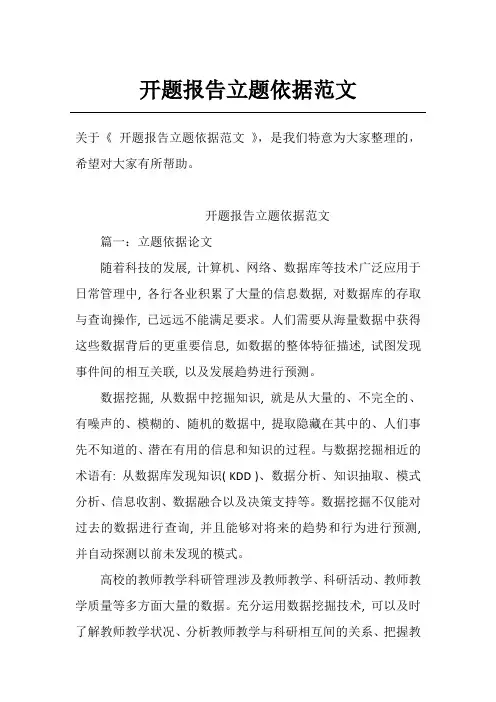
开题报告立题依据范文关于《开题报告立题依据范文》,是我们特意为大家整理的,希望对大家有所帮助。
开题报告立题依据范文篇一:立题依据论文随着科技的发展, 计算机、网络、数据库等技术广泛应用于日常管理中, 各行各业积累了大量的信息数据, 对数据库的存取与查询操作, 已远远不能满足要求。
人们需要从海量数据中获得这些数据背后的更重要信息, 如数据的整体特征描述, 试图发现事件间的相互关联, 以及发展趋势进行预测。
数据挖掘, 从数据中挖掘知识, 就是从大量的、不完全的、有噪声的、模糊的、随机的数据中, 提取隐藏在其中的、人们事先不知道的、潜在有用的信息和知识的过程。
与数据挖掘相近的术语有: 从数据库发现知识( KDD )、数据分析、知识抽取、模式分析、信息收割、数据融合以及决策支持等。
数据挖掘不仅能对过去的数据进行查询, 并且能够对将来的趋势和行为进行预测, 并自动探测以前未发现的模式。
高校的教师教学科研管理涉及教师教学、科研活动、教师教学质量等多方面大量的数据。
充分运用数据挖掘技术, 可以及时了解教师教学状况、分析教师教学与科研相互间的关系、把握教学与科研方面的异常现象等, 从而增强教学与教学管理改革的针对性, 提高管理工作的效率和质量。
通过本课题,学生可以进一步了解数据挖掘技术的相关概念,结合数据挖掘过程中数据收集、数据清洗、数据规范、关联规则挖掘、决策树和系统分析设计技术,科学合理的分析高校教师教学科研管理数据和课程任务安排、教学之间的潜在关联关系并进行预测分析。
毕业论文,使学生熟悉科研论文的写作结构,较为深入的了解数据挖掘算法及其在大学生课程学习数据中的应用,进而增强学生独立解决实际问题的能力。
研究目标:本课题拟利用设数据挖掘(Data Mining)及关联规则挖掘、决策树、以及聚类等技术,利用学院已有的大学生四年课程学习数据,通过分析学院的学生学习数据,对大学生四年学习中的课程进行关联分析,对教育数据进行挖掘”,用以挖掘隐含在数据中的、对学院管理部门有用的未知数据;并适时利用已有数据进行关联分析与预测,为未来学院的课程设置调整等提供决策支持。
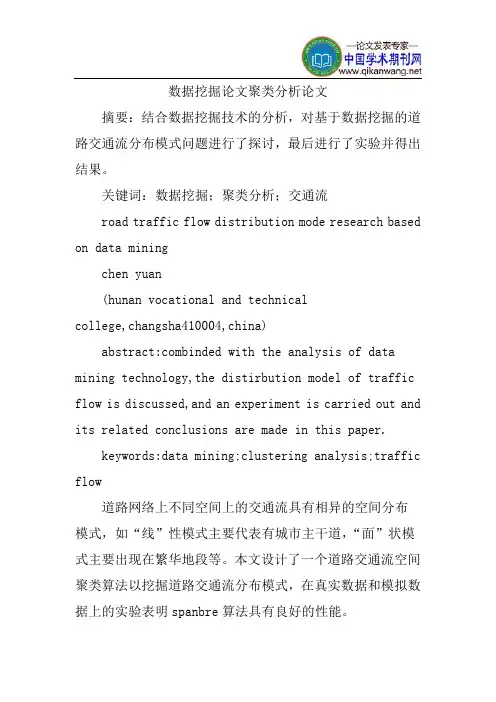
数据挖掘论文聚类分析论文摘要:结合数据挖掘技术的分析,对基于数据挖掘的道路交通流分布模式问题进行了探讨,最后进行了实验并得出结果。
关键词:数据挖掘;聚类分析;交通流road traffic flow distribution mode research based on data miningchen yuan(hunan vocational and technicalcollege,changsha410004,china)abstract:combinded with the analysis of data mining technology,the distirbution model of traffic flow is discussed,and an experiment is carried out and its related conclusions are made in this paper.keywords:data mining;clustering analysis;traffic flow道路网络上不同空间上的交通流具有相异的空间分布模式,如“线”性模式主要代表有城市主干道,“面”状模式主要出现在繁华地段等。
本文设计了一个道路交通流空间聚类算法以挖掘道路交通流分布模式,在真实数据和模拟数据上的实验表明spanbre算法具有良好的性能。
数据挖掘(datamining),也称数据库的知识发现(knowledgediseoveryindatabase)是指从随机、模糊的受到一定影响的大容量实际应用数据样本中,获取其中隐含的事前未被人们所知具有潜在价值的信息和知识的过程。
数据挖掘非独立概念,它涉及很多学科领域和方法,如有人工智能、数据统计、可视化并行计算等。
数据挖掘的分类有很多,以挖掘任务为区别点,可以划分为模型发现、聚类、关联规则发现、序列分析、偏差分析、数据可视化等类型。
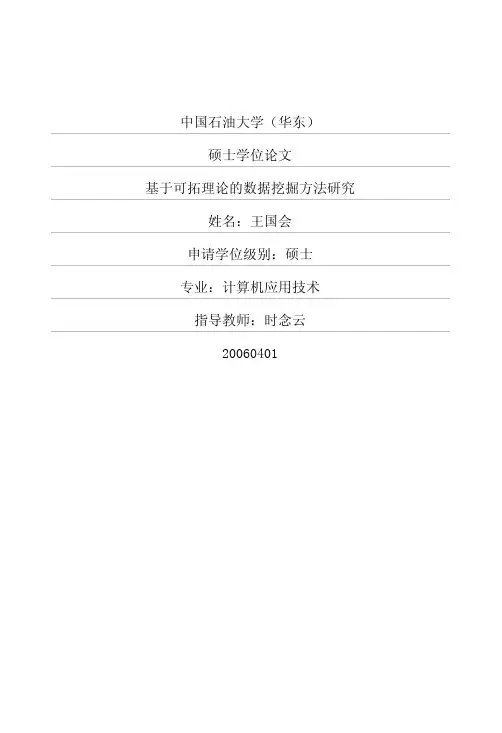
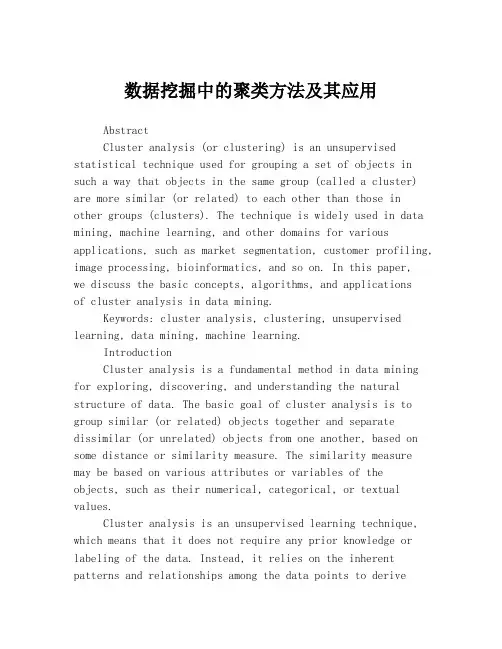
数据挖掘中的聚类方法及其应用AbstractCluster analysis (or clustering) is an unsupervised statistical technique used for grouping a set of objects in such a way that objects in the same group (called a cluster) are more similar (or related) to each other than those inother groups (clusters). The technique is widely used in data mining, machine learning, and other domains for various applications, such as market segmentation, customer profiling, image processing, bioinformatics, and so on. In this paper,we discuss the basic concepts, algorithms, and applicationsof cluster analysis in data mining.Keywords: cluster analysis, clustering, unsupervised learning, data mining, machine learning.IntroductionCluster analysis is a fundamental method in data mining for exploring, discovering, and understanding the natural structure of data. The basic goal of cluster analysis is to group similar (or related) objects together and separate dissimilar (or unrelated) objects from one another, based on some distance or similarity measure. The similarity measure may be based on various attributes or variables of the objects, such as their numerical, categorical, or textual values.Cluster analysis is an unsupervised learning technique, which means that it does not require any prior knowledge or labeling of the data. Instead, it relies on the inherent patterns and relationships among the data points to derivemeaningful clusters. To achieve this goal, various clustering algorithms have been developed, each with its strengths and weaknesses, depending on the characteristics of the data and the objectives of the analysis.In this paper, we provide an overview of the main typesof clustering algorithms, their advantages and limitations, and some applications of cluster analysis in various domains.Types of Clustering AlgorithmsThere are several types of clustering algorithms, depending on the assumptions, criteria, and methods used for clustering the data. Some of the main types are:1. Partitioning methods: These methods divide the data into k non-overlapping clusters, where k is a predefined number of clusters. The most famous partitioning algorithm is the k-means algorithm, which iteratively assigns the data points to the nearest centroid (or mean) of the cluster and updates the centroids until convergence.2. Hierarchical methods: These methods create a tree-like structure (also known as dendrogram) that represents the nested clusters of the data at multiple levels of granularity. The two main types of hierarchical clustering are agglomerative (bottom-up) and divisive (top-down) clustering. The former starts with each data point as a cluster andmerges the closest pairs of clusters until all data points belong to a single cluster. The latter starts with the entire dataset as a cluster and recursively splits it into smaller clusters until each cluster contains only one data point.3. Density-based methods: These methods use the local density of the data points to identify the clusters, rather than assuming a fixed number of clusters or a hierarchical structure. The most popular density-based algorithm is theDBSCAN algorithm, which defines a neighborhood around each data point and groups the points that have a density above a threshold.4. Model-based methods: These methods assume that the data points are generated from a probabilistic model or a mixture of models, and use Bayesian inference or maximum likelihood estimation to estimate the parameters of the model(s) and assign the data points to the clusters. The most common model-based algorithms are the Gaussian mixture model (GMM), the Bayesian information criterion (BIC), and the expectation-maximization (EM) algorithm.Advantages and Limitations of Clustering AlgorithmsEach type of clustering algorithm has its advantages and limitations, depending on the nature of the data, the objectives of the analysis, and the computational resources available. Some of the main advantages and limitations are:1. Partitioning methods are easy to implement and efficient for large datasets, but they may converge to local optima and require a prior knowledge of the number of clusters.2. Hierarchical methods provide a complete picture of the cluster structure at various levels of granularity, but they are computationally expensive and may produce clustersof various shapes and sizes.3. Density-based methods can handle noise and outliersin the data, but they may not work well for datasets with different densities or shapes of clusters.4. Model-based methods can capture the underlying generative process of the data and provide probabilistic estimates of the cluster membership, but they may require a strong assumption of the model and may not be suitable forhigh-dimensional and non-linear data.Applications of Clustering AlgorithmsCluster analysis has numerous applications in various domains, ranging from business to science to engineering. Some of the main applications are:1. Market segmentation: clustering can be used to segment customers based on their demographics, behavior, or preferences, and target them with personalized marketing strategies.2. Image processing: clustering can be used to group pixels or regions in an image based on their color, texture, or shape, and extract features or objects of interest.3. Bioinformatics: clustering can be used to classify genes or proteins based on their expression patterns, sequences, or functions, and identify biomarkers or drug targets.4. Social network analysis: clustering can be used to detect communities or groups of users based on their interactions or interests, and analyze the structure and dynamics of the network.5. Anomaly detection: clustering can be used to detect outliers or anomalous events in the data, and alert the users or take corrective actions.ConclusionCluster analysis is a powerful and flexible technique in data mining that can reveal the natural structure of data and support various applications in business, science, and engineering. The choice of clustering algorithm depends on the nature of the data, the objectives of the analysis, and the computational resources available. To obtain reliable and meaningful clusters, it is important to preprocess the data,choose an appropriate distance or similarity measure, and validate the clustering results.。
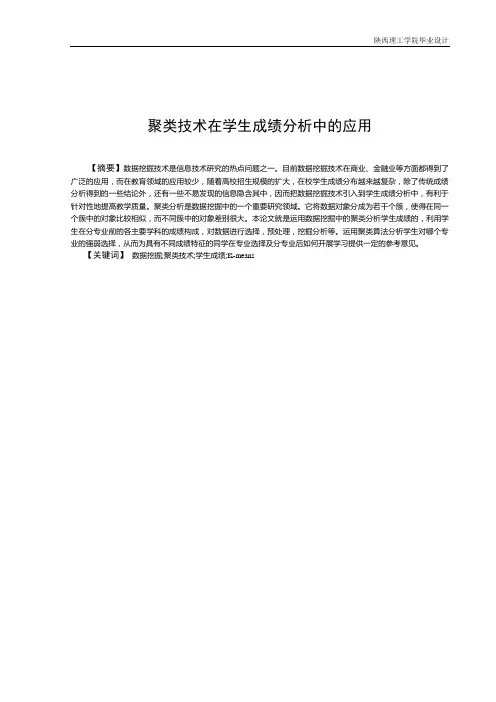
聚类技术在学生成绩分析中的应用【摘要】数据挖掘技术是信息技术研究的热点问题之一。
目前数据挖掘技术在商业、金融业等方面都得到了广泛的应用,而在教育领域的应用较少,随着高校招生规模的扩大,在校学生成绩分布越来越复杂,除了传统成绩分析得到的一些结论外,还有一些不易发现的信息隐含其中,因而把数据挖掘技术引入到学生成绩分析中,有利于针对性地提高教学质量。
聚类分析是数据挖掘中的一个重要研究领域。
它将数据对象分成为若干个簇,使得在同一个簇中的对象比较相似,而不同簇中的对象差别很大。
本论文就是运用数据挖掘中的聚类分析学生成绩的,利用学生在分专业前的各主要学科的成绩构成,对数据进行选择,预处理,挖掘分析等。
运用聚类算法分析学生对哪个专业的强弱选择,从而为具有不同成绩特征的同学在专业选择及分专业后如何开展学习提供一定的参考意见。
【关键词】数据挖掘;聚类技术;学生成绩;K-means.The Application of Cluster Technology in Analysis forStudents’ AchievementAbstract: The technology of data mining is one of the hot issues in the information technology field. Nowadays data mining technology is widely used in business and finance. But it is less used in education field. With the increase of enrollment in universities, there are more and more students in campus, and that makes it more and more complex in the distribution of students" records. Besides some conclusions from traditional record analysis, a lot of potential information cannot be founded. Importing the data mining technology to students" record analyzing makes it more convenient and improve the teaching quality. Clustering analysis is an important research field in data mining. It classify data object to many groups so that the object is similar in the same clusters, different in the different clusters. In this paper, clustering technique in data mining is used to students' performance analysis, the use of data structure of main subject before the students specialized in choice of mode, pretreatment and data mining. Using clustering technology to analyse which professional students are good at, so as to choose how to learn professional and give some reference opinions after students of different grades choose their majors.Key words: Data Mining; ClusterinTechnology; Students' Achievement; k-means目录引言 (1)1 概述 (2)1.1课题背景 (2)1.2发展现状 (2)1.3课题意义 (3)1.4本文研究内容 (3)2 数据挖掘理论概述 (4)2.1数据挖掘概述 (4)2.1.1 数据挖掘的定义 (4)2.1.2 数据挖掘的过程 (4)2.2聚类分析 (5)2.2.1 聚类分析概述 (5)2.2.2 聚类分析原理方法 (5)2.2.3 聚类分析工具 (6)3 算法介绍 (7)3.1K-means算法 (7)3.1.1K-means算法描述 (7)3.1.2k-means算法的特点 (8)4 聚类分析的应用 (9)4.1算法实现 (9)4.1.1 数据准备 (9)4.1.2 数据预处理 (10)4.1.3 算法应用 (11)4.2结果分析 (13)4.2.1 聚类结果 (13)4.2.2 结果分析 (19)4.3结论 (19)总结 (20)致谢 (21)参考文献 (22)科技外文文献 (23)中文译文 (26)引言在高校学生成绩管理中,影响学生学习成绩的因素很多,因此要进行综合分析。
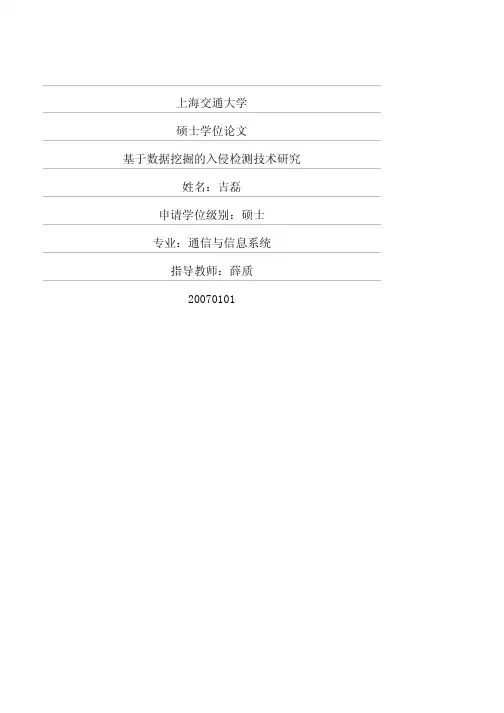

Data-mining-clustering数据挖掘—聚类分析大学毕业论文外文文献翻译及原文毕业设计(论文)外文文献翻译文献、资料中文题目:聚类分析文献、资料英文题目:clustering文献、资料来源:文献、资料发表(出版)日期:院(部):专业:自动化班级:姓名:学号:指导教师:翻译日期: 2017.02.14外文翻译英文名称:Data mining-clustering译文名称:数据挖掘—聚类分析专业:自动化姓名:****班级学号:****指导教师:******译文出处:Data mining:Ian H.Witten, EibeFrank 著Clustering5.1 INTRODUCTIONClustering is similar to classification in that data are grouped. However, unlike classification, the groups are not predefined. Instead, the grouping is accomplished by finding similarities between data according to characteristics found in the actualdata. The groups are called clusters. Some authors view clustering as a special type of classification. In this text, however, we follow a more conventional view in that the two are different. Many definitions for clusters have been proposed:●Set of like elements. Elements from different clusters are not alike.●The distance between points in a cluster is less than the distance betweena point in the cluster and any point outside it.A term similar to clustering is database segmentation, where like tuple (record) in a database are grouped together. This is done to partition or segment the database into components that then give the user a more general view of the data. In this case text, we do not differentiate between segmentation and clustering. A simple example of clustering is found in Example 5.1. This example illustrates the fact that that determining how to do the clustering is not straightforward.As illustrated in Figure 5.1, a given set of data may be clustered on different attributes. Here a group of homes in a geographic area is shown. The first floor type of clustering is based on the location of the home. Homes that are geographically close to each other are clustered together. In the second clustering, homes are grouped based on the size of the house.Clustering has been used in many application domains, including biology, medicine, anthropology, marketing, and economics. Clustering applications include plant and animal classification, disease classification, image processing, pattern recognition, and document retrieval. One of the first domains in which clustering was used was biological taxonomy. Recent usesinclude examining Web log data to detect usage patterns.When clustering is applied to a real-world database, many interesting problems occur:●Outlier handling is difficult. Here the elements do not naturally fallinto any cluster. They can be viewed as solitary clusters. However, if aclustering algorithm attempts to find larger clusters, these outliers will beforced to be placed in some cluster. This process may result in the creationof poor clusters by combining two existing clusters and leaving the outlier in its own cluster.● Dynamic data in the database implies that cluster membership may change over time.● Interpreting the semantic meaning of each cluster may be difficult. With classification, the labeling of the classes is known ahead of time. However, with clustering, this may not be the case. Thus, when the clustering process finishes creating a set of clusters, the exact meaning of each cluster may not be obvious. Here is where a domain expert is needed to assign a label or interpretation for each cluster.● There is no one correct answer to a clustering problem. In fact, many answers may be found. The exact number of clusters required is not easy to determine. Again, a domain expert may be required. For example, suppose we have a set of data about plants that have been collected during a field trip. Without any prior knowledge of plant classification, if we attempt to divide this set of data into similar groupings, it would not be clear how many groups should be created.● Another related iss ue is what data should be used of clustering. Unlike learning during a classification process, where there is some a priori knowledge concerning what the attributes of each classification should be, in clustering we have no supervised learning to aid the process. Indeed, clustering can be viewed as similar to unsupervised learning.We can then summarize some basic features of clustering (as opposed to classification):● The (best) number of clusters is not known.● There may not be any a priori knowledge co ncerning the clusters. ● Cluster results are dynamic.The clustering problem is stated as shown in Definition 5.1. Here we assume that the number of clusters to be created is an input value, k. The actual content (and interpretation) of each cluster,j k ,1j k ≤≤, is determined as a result of the function definition. Without loss of generality, we will view that the result of solving a clustering problem is that a set of clusters is created: K={12,,...,k k k k }.D EFINITION 5.1.Given a database D ={12,,...,n t t t } of tuples and aninteger value k , the clustering problem is to define a mapping f : {1,...,}D k → where each i t is assigned to one cluster j K ,1j k ≤≤. A cluster j K , contains precisely those tuples mapped to it; that is,j K ={|(),1,i i j t f t K i n =≤≤and i t D ∈}.A classification of the different types of clustering algorithms is shown in Figure 5.2. Clustering algorithms themselves may be viewed as hierarchical or partitional. With hierarchical clustering, a nested set of clusters is created. Each level in the hierarchy has a separate set of clusters. At the lowest level, each item is in itsown unique cluster. At the highest level, all items belong to the same cluster. With hierarchical clustering, the desired number of clusters is not input. With partitional clustering, the algorithm creates only one set of clusters. These approaches use the desired number of clusters to drive how the final set is created. Traditional clustering algorithms tend to be targeted to small numeric database that fit into memory .There are, however, more recent clustering algorithms that look at categorical data and are targeted to larger, perhaps dynamic, databases. Algorithms targeted to larger databases may adapt to memory constraints by either sampling the database or using data structures, which can be compressed or pruned to fit into memory regardless of the size of the database. Clustering algorithms may also differ based on whether they produce overlapping or nonoverlapping clusters. Even though we consider only nonoverlapping clusters, it is possible to place an item in multiple clusters. In turn, nonoverlapping clusters can be viewed as extrinsic or intrinsic. Extrinsic techniques use labeling of the items to assist in the classification process. These algorithms are the traditional classification supervised learning algorithms in which a special input training set is used. Intrinsic algorithms do not use any a priori category labels, but depend only on the adjacency matrix containing the distance between objects. All algorithms we examine in this chapter fall into the intrinsic class.The types of clustering algorithms can be furthered classified based on the implementation technique used. Hierarchical algorithms can becategorized as agglomerat ive or divisive. ”Agglomerative ” implies that the clusters are created in a bottom-up fashion, while divisive algorithms work in a top-down fashion. Although bothhierarchical and partitional algorithms could be described using the agglomerative vs. divisive label, it typically is more associated with hierarchical algorithms. Another descriptive tag indicates whether each individual element is handled one by one, serial (sometimes called incremental), or whether all items are examined together, simultaneous. If a specific tuple is viewed as having attribute values for all attributes in the schema, then clustering algorithms could differ as to how the attribute values are examined. As is usually done with decision tree classification techniques, some algorithms examine attribute values one at a time, monothetic. Polythetic algorithms consider all attribute values at one time. Finally, clustering algorithms can be labeled base on the mathematical formulation given to the algorithm: graph theoretic or matrix algebra. In this chapter we generally use the graph approach and describe the input to the clustering algorithm as an adjacency matrix labeled with distance measure.We discuss many clustering algorithms in the following sections. This is only a representative subset of the many algorithms that have been proposed in the literature. Before looking at these algorithms, we first examine possible similarity measures and examine the impact of outliers.5.2 SIMILARITY AND DISTANCE MEASURESThere are many desirable properties for the clusters created by a solution to a specific clustering problem. The most important one is that a tuple within one cluster is more like tuples within that cluster than it is similar to tuples outside it. As with classification, then, we assume the definition of a similarity measure, sim(,i l t t ), defined between any two tuples, ,i l t t D . This provides a more strict and alternative clustering definition, as found in Definition 5.2. Unless otherwise stated, we use thefirst definition rather than the second. Keep in mind that the similarity relationship stated within the second definition is a desirable, although not always obtainable, property.A distance measure, dis(,i j t t ), as opposed to similarity, is often used in。
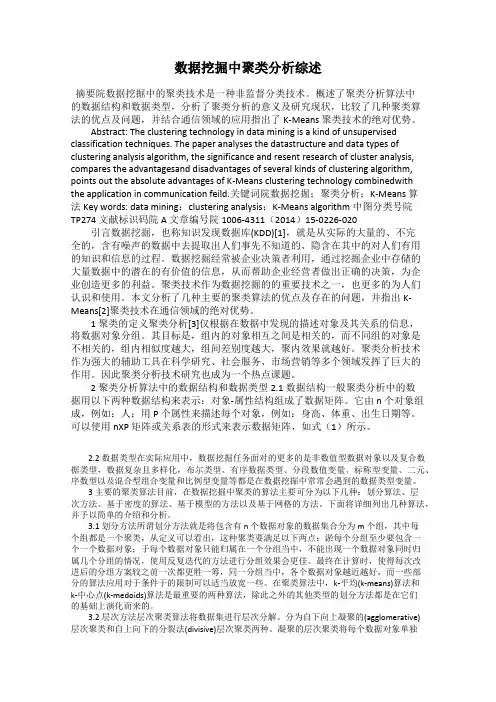
数据挖掘中聚类分析综述摘要院数据挖掘中的聚类技术是一种非监督分类技术。
概述了聚类分析算法中的数据结构和数据类型,分析了聚类分析的意义及研究现状,比较了几种聚类算法的优点及问题,并结合通信领域的应用指出了K-Means 聚类技术的绝对优势。
Abstract: The clustering technology in data mining is a kind of unsupervised classification techniques. The paper analyses the datastructure and data types of clustering analysis algorithm, the significance and resent research of cluster analysis, compares the advantagesand disadvantages of several kinds of clustering algorithm, points out the absolute advantages of K-Means clustering technology combinedwiththe application in communication feild.关键词院数据挖掘;聚类分析;K-Means 算法Key words: data mining;clustering analysis;K-Means algorithm中图分类号院TP274 文献标识码院A 文章编号院1006-4311(2014)15-0226-020引言数据挖掘,也称知识发现数据库(KDD)[1],就是从实际的大量的、不完全的,含有噪声的数据中去提取出人们事先不知道的、隐含在其中的对人们有用的知识和信息的过程。
数据挖掘经常被企业决策者利用,通过挖掘企业中存储的大量数据中的潜在的有价值的信息,从而帮助企业经营者做出正确的决策,为企业创造更多的利益。
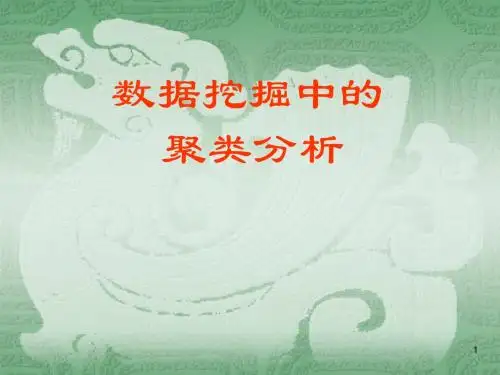
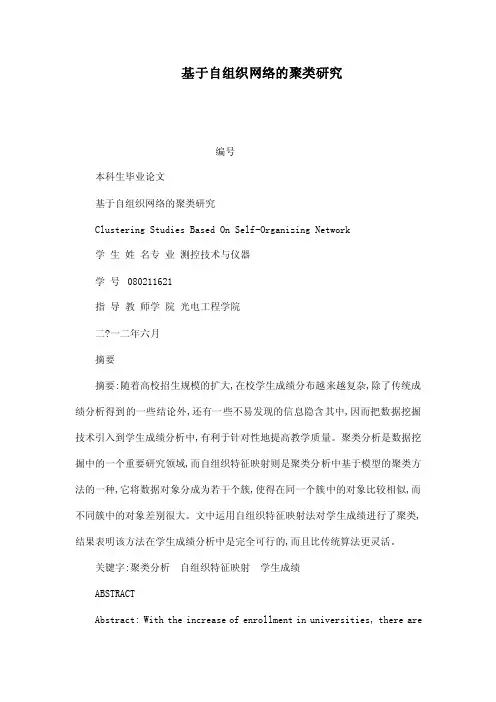
基于自组织网络的聚类研究编号本科生毕业论文基于自组织网络的聚类研究Clustering Studies Based On Self-Organizing Network学生姓名专业测控技术与仪器学号080211621指导教师学院光电工程学院二?一二年六月摘要摘要:随着高校招生规模的扩大,在校学生成绩分布越来越复杂,除了传统成绩分析得到的一些结论外,还有一些不易发现的信息隐含其中,因而把数据挖掘技术引入到学生成绩分析中,有利于针对性地提高教学质量。
聚类分析是数据挖掘中的一个重要研究领域,而自组织特征映射则是聚类分析中基于模型的聚类方法的一种,它将数据对象分成为若干个簇,使得在同一个簇中的对象比较相似,而不同簇中的对象差别很大。
文中运用自组织特征映射法对学生成绩进行了聚类,结果表明该方法在学生成绩分析中是完全可行的,而且比传统算法更灵活。
关键字:聚类分析自组织特征映射学生成绩ABSTRACTAbstract: With the increase of enrollment in universities, there aremore and more students in campus, and that makes it more and more complex in the distribution of students’ records. Besides some conclusions from traditional record analysis, a lot of potential information cannot be founded. Importing the data mining technology to students record analyzing makes it more convenient and it can also improve the teaching quality. Clustering analysis is an important research field in data mining. In this paper the self-organizing map is used to cluster the student achievements .It classifies data object to many groups so that the object are similar in the same clusters, different in the different clusters. The self-organizing map is a model-based clustering method in cluster analysis. The results show that this method is entirely possible in the analysis of students’ achievements, and more flexible than traditional methods.Key words: Clustering Analysis; The Self-organizing Map; Students' Achievement目录摘要IABSTRACT II第一章绪论 11.1课题的背景 11.2课题研究的内容 11.3传统的研究方法 11.4课题采用的研究方法 3第二章聚类分析 42.1聚类分析概述 42.2聚类算法性能的要求 42.3聚类分析的原理方法 5第三章自组织特征映射神经网络及MATLAB 83.1自组织神经网络概述83.1.1自组织神经网络历史83.1.2自组织神经网络结构83.1.3自组织神经网络的原理93.2自组织神经网络模型与算法113.3MALTAB概述15第四章自组织神经网络在学生成绩分析中的应用17 4.1算法实现174.2数据收集及分析174.3 MATLAB实现过程174.4结果分析18第五章结论20参考文献21致谢22附录23第一章绪论1.1课题的背景随着高校学生人数大幅度增加,以及教学管理模式的转变如学分制等都给学校的教务管理工作带来了诸多向题,使得教务管理越来越复杂。
基于数据挖掘的网络学习行为分析及其教学策略研究方静(湖北工业大学,湖北省武汉市,430068)摘要:随着信息技术的快速发展和网络技术的广泛应用,对传统的学习方式产生了很人的冲击,基于网络环境的教学已经成为一种重要的形式和学校教学的组成部分。
作为一种新生的学习方式,网络学习有其独特的优势和发展潜力,网络学习包括四人要素:学习者要素、教师要素、网络课程内容要素及网络学习环境要素,每一种要素之间的相互关系都会影响网络学习的有效性,随着网络学习普及性的提高,对网络学习有效性的关注尤为重要,日前对此问题所进行的思辨研究比较多。
而当前大学生已经基本掌握电子计算机和网络使用的基本技能,将数据挖掘作为当前大学生网络学习的基础,通过学习者要素、教师要素、网络课程内容和网络学习环境为要点,研究大学生的网络学习行为,从而有针对性的引导大学生有效学习。
本文拟通过分析研究,应用数据挖掘方法探讨网络学习的有效性,并基于数据挖掘的分析结果提出网络学习的引导策略。
关键词:网络学习、有效学习、数据挖掘、关联规则、多维度分类1 引言随着计算机网络技术的发展和互联网的普及,网络教育正以迅猛的态势发展起来。
我国的远程教育正式进入了第三个发展阶段—以多媒体计算机和网络教育为代表的现代远程教育。
网络环境下教与学的时空分离造成了教与学相互作用的弱化,应用数据挖掘方法研究网络环境下教与学相互作用的关系,可以有效探索网络学习新机制,为网络环境下的学习者、教师、课程开发者和管理者提供服务,指导他们在网络环境下进行教与学的实践,以提高教育管理绩效和学习绩效。
目前对于网络学习行为的研究,国内外学者主要集中在对网络学习者行为特征的统计及描述、网络学习行为监控系统的设计与实现、网络学习行为模型的构建及网络学习行为交互及反馈机制的探讨等几方面。
笔者从 CNKI 中以数据挖掘、数据挖掘和网络(Web)等一系列关键词进行搜索,从搜索结果可以看出,我国在数据挖掘领域的研究自 1996 年左右起步以后,研究成果逐年递增。
数据挖掘技术毕业论文中英文资料对照外文翻译文献综述数据挖掘技术简介中英文资料对照外文翻译文献综述英文原文Introduction to Data MiningAbstract:Microsoft® SQL Server™ 2005 provides an integrated environment for creating and working with data mining models. This tutorial uses four scenarios, targeted mailing, forecasting, market basket, and sequence clustering, to demonstrate how to use the mining model algorithms, mining model viewers, and data mining tools that are included in this release of SQL Server.IntroductionThe data mining tutorial is designed to walk you through the process of creating data mining models in Microsoft SQL Server 2005. The data mining algorithms and tools in SQL Server 2005 make it easy to build a comprehensive solution for a variety of projects, including market basket analysis, forecasting analysis, and targeted mailing analysis. The scenarios for these solutions are explained in greater detail later in the tutorial.The most visible components in SQL Server 2005 are the workspaces that you use to create and work with data mining models. The online analytical processing (OLAP) and data mining tools are consolidated into two working environments: Business Intelligence Development Studio and SQL Server Management Studio. Using Business Intelligence Development Studio, you can develop an Analysis Services project disconnected from the server. When the project is ready, you can deploy it to the server. You can also work directly against the server. The main function of SQL Server Management Studio is to manage the server. Each environment is described in more detail later in this introduction. For more information on choosing between the two environments, see "Choosing Between SQL Server Management Studio and Business Intelligence Development Studio" in SQL Server Books Online.All of the data mining tools exist in the data mining editor. Using the editor you can manage mining models, create new models, view models, compare models, and create predictions basedon existing models.After you build a mining model, you will want to explore it, looking for interesting patterns and rules. Each mining model viewer in the editor is customized to explore models built with a specific algorithm. For more information about the viewers, see "Viewing a Data Mining Model" in SQL Server Books Online.Often your project will contain several mining models, so before you can use a model to create predictions, you need to be able to determine which model is the most accurate. For this reason, the editor contains a model comparison tool called the Mining Accuracy Chart tab. Using this tool you can compare the predictive accuracy of your models and determine the best model.To create predictions, you will use the Data Mining Extensions (DMX) language. DMX extends SQL, containing commands to create, modify, and predict against mining models. For more information about DMX, see "Data Mining Extensions (DMX) Reference" in SQL Server Books Online. Because creating a prediction can be complicated, the data mining editor contains a tool called Prediction Query Builder, which allows you to build queries using a graphical interface. You can also view the DMX code that is generated by the query builder.Just as important as the tools that you use to work with and create data mining models are the mechanics by which they are created. The key to creating a mining model is the data mining algorithm. The algorithm finds patterns in the data that you pass it, and it translates them into a mining model — it is the engine behind the process.Some of the most important steps in creating a data mining solution are consolidating, cleaning, and preparing the data to be used to create the mining models. SQL Server 2005 includes the Data Transformation Services (DTS) working environment, which contains tools that you can use to clean, validate, and prepare your data. For more information on using DTS in conjunction with a data mining solution, see "DTS Data Mining Tasks and Transformations" in SQL Server Books Online.In order to demonstrate the SQL Server data mining features, this tutorial uses a new sample database called AdventureWorksDW. The database is included with SQL Server 2005, and it supports OLAP and data mining functionality. In order to make the sample database available, you need to select the sample database at the installation time in the “Advanced” dialog for component selection.Adventure WorksAdventureWorksDW is based on a fictional bicycle manufacturing company named Adventure Works Cycles. Adventure Works produces and distributes metal and composite bicycles to North American, European, and Asian commercial markets. The base of operations is located in Bothell, Washington with 500 employees, and several regional sales teams are located throughout their market base.Adventure Works sells products wholesale to specialty shops and to individuals through theInternet. For the data mining exercises, you will work with the AdventureWorksDW Internet sales tables, which contain realistic patterns that work well for data mining exercises.For more information on Adventure Works Cycles see "Sample Databases and Business Scenarios" in SQL Server Books Online.Database DetailsThe Internet sales schema contains information about 9,242 customers. These customers live in six countries, which are combined into three regions:North America (83%)Europe (12%)Australia (7%)The database contains data for three fiscal years: 2002, 2003, and 2004.The products in the database are broken down by subcategory, model, and product.Business Intelligence Development StudioBusiness Intelligence Development Studio is a set of tools designed for creating business intelligence projects. Because Business Intelligence Development Studio was created as an IDE environment in which you can create a complete solution, you work disconnected from the server. You can change your data mining objects as much as you want, but the changes are not reflected on the server until after you deploy the project.Working in an IDE is beneficial for the following reasons:The Analysis Services project is the entry point for a business intelligence solution. An Analysis Services project encapsulates mining models and OLAP cubes, along with supplemental objects that make up the Analysis Services database. From Business Intelligence Development Studio, you can create and edit Analysis Services objects within a project and deploy the project to the appropriate Analysis Services server or servers.If you are working with an existing Analysis Services project, you can also use Business Intelligence Development Studio to work connected the server. In this way, changes are reflected directly on the server without having to deploy the solution.SQL Server Management StudioSQL Server Management Studio is a collection of administrative and scripting tools for working with Microsoft SQL Server components. This workspace differs from Business Intelligence Development Studio in that you are working in a connected environment where actions are propagated to the server as soon as you save your work.After the data has been cleaned and prepared for data mining, most of the tasks associated with creating a data mining solution are performed within Business Intelligence Development Studio. Using the Business Intelligence Development Studio tools, you develop and test the datamining solution, using an iterative process to determine which models work best for a given situation. When the developer is satisfied with the solution, it is deployed to an Analysis Services server. From this point, the focus shifts from development to maintenance and use, and thus SQL Server Management Studio. Using SQL Server Management Studio, you can administer your database and perform some of the same functions as in Business Intelligence Development Studio, such as viewing, and creating predictions from mining models.Data Transformation ServicesData Transformation Services (DTS) comprises the Extract, Transform, and Load (ETL) tools in SQL Server 2005. These tools can be used to perform some of the most important tasks in data mining: cleaning and preparing the data for model creation. In data mining, you typically perform repetitive data transformations to clean the data before using the data to train a mining model. Using the tasks and transformations in DTS, you can combine data preparation and model creation into a single DTS package.DTS also provides DTS Designer to help you easily build and run packages containing all of the tasks and transformations. Using DTS Designer, you can deploy the packages to a server and run them on a regularly scheduled basis. This is useful if, for example, you collect data weekly data and want to perform the same cleaning transformations each time in an automated fashion.You can work with a Data Transformation project and an Analysis Services project together as part of a business intelligence solution, by adding each project to a solution in Business Intelligence Development Studio.Mining Model AlgorithmsData mining algorithms are the foundation from which mining models are created. The variety of algorithms included in SQL Server 2005 allows you to perform many types of analysis. For more specific information about the algorithms and how they can be adjusted using parameters, see "Data Mining Algorithms" in SQL Server Books Online.Microsoft Decision TreesThe Microsoft Decision Trees algorithm supports both classification and regression and it works well for predictive modeling. Using the algorithm, you can predict both discrete and continuous attributes.In building a model, the algorithm examines how each input attribute in the dataset affects the result of the predicted attribute, and then it uses the input attributes with the strongest relationship to create a series of splits, called nodes. As new nodes are added to the model, a tree structure begins to form. The top node of the tree describes the breakdown of the predicted attribute over the overall population. Each additional node is created based on the distribution of states of the predicted attribute as compared to the input attributes. If an input attribute is seen tocause the predicted attribute to favor one state over another, a new node is added to the model. The model continues to grow until none of the remaining attributes create a split that provides an improved prediction over the existing node. The model seeks to find a combination of attributes and their states that creates a disproportionate distribution of states in the predicted attribute, therefore allowing you to predict the outcome of the predicted attribute.Microsoft ClusteringThe Microsoft Clustering algorithm uses iterative techniques to group records from a dataset into clusters containing similar characteristics. Using these clusters, you can explore the data, learning more about the relationships that exist, which may not be easy to derive logically through casual observation. Additionally, you can create predictions from the clustering model created by the algorithm. For example, consider a group of people who live in the same neighborhood, drive the same kind of car, eat the same kind of food, and buy a similar version of a product. This is a cluster of data. Another cluster may include people who go to the same restaurants, have similar salaries, and vacation twice a year outside the country. Observing how these clusters are distributed, you can better understand how the records in a dataset interact, as well as how that interaction affects the outcome of a predicted attribute.Microsoft Naïve BayesThe Microsoft Naïve Bayes algorithm quickly builds mining models that can be used for classification and prediction. It calculates probabilities for each possible state of the input attribute, given each state of the predictable attribute, which can later be used to predict an outcome of the predicted attribute based on the known input attributes. The probabilities used to generate the model are calculated and stored during the processing of the cube. The algorithm supports only discrete or discretized attributes, and it considers all input attributes to be independent. The Microsoft Naïve Bayes algorithm produces a simple mining model that can be considered a starting point in the data mining process. Because most of the calculations used in creating the model are generated during cube processing, results are returned quickly. This makes the model a good option for exploring the data and for discovering how various input attributes are distributed in the different states of the predicted attribute.Microsoft Time SeriesThe Microsoft Time Series algorithm creates models that can be used to predict continuous variables over time from both OLAP and relational data sources. For example, you can use the Microsoft Time Series algorithm to predict sales and profits based on the historical data in a cube.Using the algorithm, you can choose one or more variables to predict, but they must be continuous. You can have only one case series for each model. The case series identifies the location in a series, such as the date when looking at sales over a length of several months or years.A case may contain a set of variables (for example, sales at different stores). The Microsoft Time Series algorithm can use cross-variable correlations in its predictions. For example, prior sales at one store may be useful in predicting current sales at another store.Microsoft Neural NetworkIn Microsoft SQL Server 2005 Analysis Services, the Microsoft Neural Network algorithm creates classification and regression mining models by constructing a multilayer perceptron network of neurons. Similar to the Microsoft Decision Trees algorithm provider, given each state of the predictable attribute, the algorithm calculates probabilities for each possible state of the input attribute. The algorithm provider processes the entire set of cases , iteratively comparing the predicted classification of the cases with the known actual classification of the cases. The errors from the initial classification of the first iteration of the entire set of cases is fed back into the network, and used to modify the network's performance for the next iteration, and so on. You can later use these probabilities to predict an outcome of the predicted attribute, based on the input attributes. One of the primary differences between this algorithm and the Microsoft Decision Trees algorithm, however, is that its learning process is to optimize network parameters toward minimizing the error while the Microsoft Decision Trees algorithm splits rules in order to maximize information gain. The algorithm supports the prediction of both discrete and continuous attributes.Microsoft Linear RegressionThe Microsoft Linear Regression algorithm is a particular configuration of the Microsoft Decision Trees algorithm, obtained by disabling splits (the whole regression formula is built in a single root node). The algorithm supports the prediction of continuous attributes.Microsoft Logistic RegressionThe Microsoft Logistic Regression algorithm is a particular configuration of the Microsoft Neural Network algorithm, obtained by eliminating the hidden layer. The algorithm supports the prediction of both discrete andcontinuous attributes.)中文译文数据挖掘技术简介摘要:微软® SQL Server™2005中提供用于创建和使用数据挖掘模型的集成环境的工作。
数据挖掘中聚类分析的技术方法汤效琴戴汝源摘要:数据挖掘是信息产业界近年来非常热门的研究方向,聚类分析是数据挖掘中的核心技术。
本文对数据挖掘领域的聚类分析方法及代表算法进行分析,并从多个方面对这些算法性能进行比较,同时还对聚类分析在数据挖掘中的几个应用进行了阐述。
关键词:数据挖掘;聚类分析;聚类算法Technique of Cluster analysis in Data miningTang Xiaoqin Dai Ruyuan(Computer Center Ningxia University, Yinchuan 750021,China) Abstract: Data Mining is one of the pop research in information industry last few years. Cluster analysis is the core technique of Data Mining. This paper analyzes the cluster analysis method and representation cluster algorithm in the area of the Data Mining, and compares the algorithm capability. And also expatiate the application of the cluster analysis in Data Mining.Keywords: Data Mining; Cluster analysis; Cluster algorithm0 引言数据挖掘(Data Mining)是指从存放在数据库、数据仓库或其他信息库中的大量数据中提取隐含的、未知的、有潜在应用价值的信息或模式的过程。
数据挖掘涉及多学科技术,包括数据库技术、统计学、机器学习、高性能计算、模式识别、神经网络、数据可视化、信息检索、图像与信号处理和空间数据分析。
Summary of Data Mining Clustering Algorithm 作者: 方媛[1];车启凤[2]
作者机构: [1]河西学院信息技术中心;[2]河西学院信息技术与传媒学院,甘肃张掖734000出版物刊名: 河西学院学报
页码: 72-76页
年卷期: 2012年 第5期
主题词: 数据挖掘;聚类算法
摘要:近年来,数据挖掘技术的研究备受国内外关注,其主要原因是信息技术发展产生了大量分散的数据,迫切需要将这些数据转换成有用的信息和知识.此前的研究,主要集中于分类算法及应用方面的研究,但某些特殊领域,如生物信息学研究等,需要通过聚类方法解决一些实际问题.本文从横向深入分析了数据挖掘技术中聚类算法的发展,对层次法、划分法、模糊法,以及量子聚类、核聚类,基于密度和网格等10种聚类算法的原理、过程和特点等都进行了比校详细的分析论述.。
!!!!!!!!!!!!!!!!!!!!!!!!!!!!!!!!!!!!!!!!!科技情报开发与经济SCI-TECHINFORMATIONDEVELOPMENT&ECONOMY2008年第18卷第6期TheImplementationofStoreProcedureCalledbytheApplicationPrograminJavaCHANGChun-yanABSTRACT:ThispaperintroducessomemethodsforcallingSQLServerstoreprocedureintheapplicationprogram,andgivestheconcreteimplementingproceduresinJavaprogrammingenvironment.KEYWORDS:SQLServer;storeprocedure;Java出版社,2003:253-254.[2]刘独玉,罗彬.基于MSSQLServer的存储过程的研究与应用[J].四川轻化工学院学报,2001,6(2):25-32.[3]郭琳.浅谈在ASP中调用SQLServer存储过程[J].四川职业技术学院学报,2006(4):22-24.(责任编辑:戚米莎)───────────────第一作者简介:常春燕,女,1976年2月生,2006年毕业于中北大学(硕士),助教,太原理工大学轻纺工程与美术学院,山西省晋中市榆次区,030600.数据挖掘是计算机行业发展最快的领域之一。
以前数据挖掘只是结合了计算机科学和统计学而产生的一个让人感兴趣的小领域,如今,它已经迅速扩大成为一个独立的领域。
数据挖掘的强大力量之一在于它具有广泛的方法和技术,以应用于大量的问题集。
数据挖掘是一个在大型数据集上进行的自然行为,其最大的目标市场应该是整个数据仓库、数据集市和决策支持业界。
1数据挖掘过程有些人认为数据挖掘只是采摘和应用基于计算机的工具来匹配出现的问题,并自动获取解决方案,这其实是一种误解。
数据挖掘中的聚类算法分析随着大数据技术的快速发展,人们积累了越来越多的数据。
然而,数据量的增加并不意味着我们可以轻松地分析、处理和理解这些数据。
这时,聚类算法便应运而生,它是一种将数据分组成不同类别的算法,以便更好地理解数据。
本文将从聚类的基本概念入手,探讨数据挖掘中的聚类算法分析。
一、聚类算法基本概念聚类是一种无监督学习方法,它根据数据样本本身的特征,将它们分为不同的类别。
聚类是从数据中发现潜在的关系和模式的一种有力工具。
在聚类中,类别指的是数据的分组,而不是预定义的类别。
聚类分析将样本组成若干个簇,使得簇内对象相似度尽可能高,簇间对象相似度尽可能低。
聚类分析的目标是使得簇内差异尽量小,簇间差异尽量大,从而帮助人们更好地理解数据。
聚类分析主要包括以下五个步骤:1.选择距离或相似性度量2.选择聚类方法3.初始簇的选择4.计算簇间距离5.终止条件二、基本聚类算法在数据挖掘中,常用的聚类算法主要有以下几种:1. K-means聚类算法K-means算法是一种基于质心的聚类算法。
它将每个数据点分配到最近的质心,然后重新计算质心。
不断迭代这个过程,直到质心的位置不再变化为止,K-means算法的效果会随着参数K的不同而有所不同,而且K必须事先已知。
2. DBSCAN聚类算法DBSCAN是一种基于密度的聚类算法。
该算法首先选定一点p,然后找出距离p相近的点,将其设为一个簇。
然后按照同样的方式继续扩展簇,直到不能再添加点为止。
该算法的优点在于它不需要事先指定簇的数量,并且能够处理噪声数据。
3.层次聚类算法层次聚类算法是一种无需预先指定聚类数量的聚类算法。
该算法首先将样本分成两个初始簇,然后按照相似性合并这些簇。
该过程会形成一个树状结构,称为聚类树。
层次聚类算法可以分为两种:凝聚聚类和分裂聚类。
三、应用案例聚类算法已经被广泛应用于各种领域。
以下是一些聚类算法在不同领域中的应用案例。
1.市场细分聚类算法已经被广泛应用于市场细分研究中。
毕业设计(论文)外文文献翻译文献、资料中文题目:聚类分析文献、资料英文题目:clustering文献、资料来源:文献、资料发表(出版)日期:院(部):专业:自动化班级:姓名:学号:指导教师:翻译日期: 2017.02.14外文翻译英文名称:Data mining-clustering译文名称:数据挖掘—聚类分析专业:自动化姓名:****班级学号:****指导教师:******译文出处:Data mining:Ian H.Witten, EibeFrank 著Clustering5.1 INTRODUCTIONClustering is similar to classification in that data are grouped. However, unlike classification, the groups are not predefined. Instead, the grouping is accomplished by finding similarities between data according to characteristics found in the actual data. The groups are called clusters. Some authors view clustering as a special type of classification. In this text, however, we follow a more conventional view in that the two are different. Many definitions for clusters have been proposed:●Set of like elements. Elements from different clusters are not alike.●The distance between points in a cluster is less than the distance betweena point in the cluster and any point outside it.A term similar to clustering is database segmentation, where like tuple (record) in a database are grouped together. This is done to partition or segment the database into components that then give the user a more general view of the data. In this case text, we do not differentiate between segmentation and clustering. A simple example of clustering is found in Example 5.1. This example illustrates the fact that that determining how to do the clustering is not straightforward.As illustrated in Figure 5.1, a given set of data may be clustered on different attributes. Here a group of homes in a geographic area is shown. The first floor type of clustering is based on the location of the home. Homes that are geographically close to each other are clustered together. In the second clustering, homes are grouped based on the size of the house.Clustering has been used in many application domains, including biology, medicine, anthropology, marketing, and economics. Clustering applications include plant and animal classification, disease classification, image processing, pattern recognition, and document retrieval. One of the first domains in which clustering was used was biological taxonomy. Recent uses include examining Web log data to detect usage patterns.When clustering is applied to a real-world database, many interesting problems occur:●Outlier handling is difficult. Here the elements do not naturally fallinto any cluster. They can be viewed as solitary clusters. However, if aclustering algorithm attempts to find larger clusters, these outliers will beforced to be placed in some cluster. This process may result in the creationof poor clusters by combining two existing clusters and leaving the outlier in its own cluster.● Dynamic data in the database implies that cluster membership may change over time.● Interpreting the semantic meaning of each cluster may be difficult. With classification, the labeling of the classes is known ahead of time. However, with clustering, this may not be the case. Thus, when the clustering process finishes creating a set of clusters, the exact meaning of each cluster may not be obvious. Here is where a domain expert is needed to assign a label or interpretation for each cluster.● There is no one correct answer to a clustering problem. In fact, many answers may be found. The exact number of clusters required is not easy to determine. Again, a domain expert may be required. For example, suppose we have a set of data about plants that have been collected during a field trip. Without any prior knowledge of plant classification, if we attempt to divide this set of data into similar groupings, it would not be clear how many groups should be created.● Another related issue is what data should be used of clustering. Unlike learning during a classification process, where there is some a priori knowledge concerning what the attributes of each classification should be, in clustering we have no supervised learning to aid the process. Indeed, clustering can be viewed as similar to unsupervised learning.We can then summarize some basic features of clustering (as opposed to classification):● The (best) number of clusters is not known.● There may not be any a priori knowledge concerning the clusters. ● Cluster results are dynamic.The clustering problem is stated as shown in Definition 5.1. Here we assume that the number of clusters to be created is an input value, k. The actual content (and interpretation) of each cluster,j k ,1j k ≤≤, is determined as a result of the function definition. Without loss of generality, we will view that the result of solving a clustering problem is that a set of clusters is created: K={12,,...,k k k k }.D EFINITION 5.1.Given a database D ={12,,...,n t t t } of tuples and an integer value k , the clustering problem is to define a mapping f : {1,...,}D k → where each i t is assigned to one cluster j K ,1j k ≤≤. A cluster j K , contains precisely those tuples mapped to it; that is, j K ={|(),1,i i j t f t K i n =≤≤and i t D ∈}.A classification of the different types of clustering algorithms is shown in Figure 5.2. Clustering algorithms themselves may be viewed as hierarchical or partitional. With hierarchical clustering, a nested set of clusters is created. Each level in the hierarchy has a separate set of clusters. At the lowest level, each item is in its own unique cluster. At the highest level, all items belong to the same cluster. With hierarchical clustering, the desired number of clusters is not input. With partitional clustering, the algorithm creates only one set of clusters. These approaches use the desired number of clusters to drive how the final set is created. Traditional clustering algorithms tend to be targeted to small numeric database that fit into memory .There are, however, more recent clustering algorithms that look at categorical data and are targeted to larger, perhaps dynamic, databases. Algorithms targeted to larger databases may adapt to memory constraints by either sampling the database or using data structures, which can be compressed or pruned to fit into memory regardless of the size of the database. Clustering algorithms may also differ based on whether they produce overlapping or nonoverlapping clusters. Even though we consider only nonoverlapping clusters, it is possible to place an item in multiple clusters. In turn, nonoverlapping clusters can be viewed as extrinsic or intrinsic. Extrinsic techniques use labeling of the items to assist in the classification process. These algorithms are the traditional classification supervised learning algorithms in which a special input training set is used. Intrinsic algorithms do not use any a priori category labels, but depend only on the adjacency matrix containing the distance between objects. All algorithms we examine in this chapter fall into the intrinsic class.The types of clustering algorithms can be furthered classified based on the implementation technique used. Hierarchical algorithms can becategorized as agglomerative or divisive. ”Agglomerative ” implies that the clusters are created in a bottom-up fashion, while divisive algorithms work in a top-down fashion. Although both hierarchical and partitional algorithms could be described using the agglomerative vs. divisive label, it typically is more associated with hierarchical algorithms. Another descriptive tag indicates whether each individual element is handled one by one, serial (sometimes called incremental), or whether all items are examined together, simultaneous. If a specific tuple is viewed as having attribute values for all attributes in the schema, then clustering algorithms could differ as to how the attribute values are examined. As is usually done with decision tree classification techniques, some algorithms examine attribute values one at a time, monothetic. Polythetic algorithms consider all attribute values at one time. Finally, clustering algorithms can be labeled base on the mathematical formulation given to the algorithm: graph theoretic or matrix algebra. In this chapter we generally use the graph approach and describe the input to the clustering algorithm as an adjacency matrix labeled with distance measure.We discuss many clustering algorithms in the following sections. This is only a representative subset of the many algorithms that have been proposed in the literature. Before looking at these algorithms, we first examine possible similarity measures and examine the impact of outliers.5.2 SIMILARITY AND DISTANCE MEASURESThere are many desirable properties for the clusters created by a solution to a specific clustering problem. The most important one is that a tuple within one cluster is more like tuples within that cluster than it is similar to tuples outside it. As with classification, then, we assume the definition of a similarity measure, sim(,i l t t ), defined between any two tuples, ,i l t t D . This provides a more strict and alternative clustering definition, as found in Definition 5.2. Unless otherwise stated, we use the first definition rather than the second. Keep in mind that the similarity relationship stated within the second definition is a desirable, although not always obtainable, property.A distance measure, dis(,i j t t ), as opposed to similarity, is often used in。